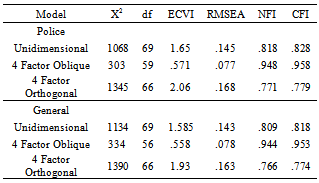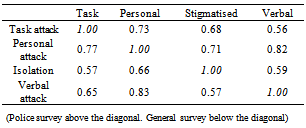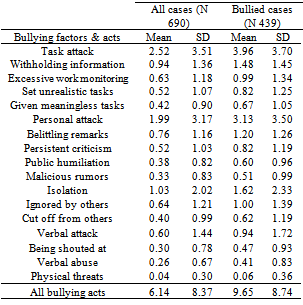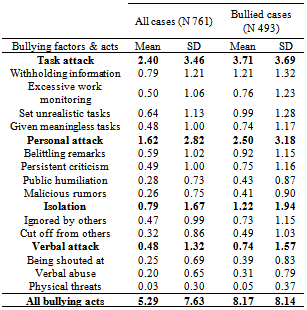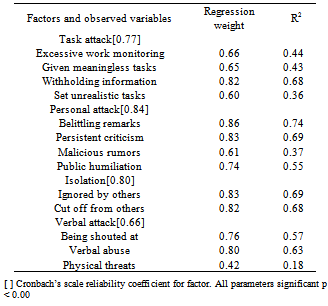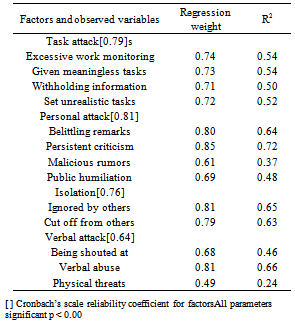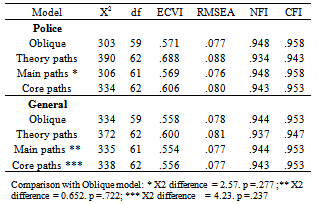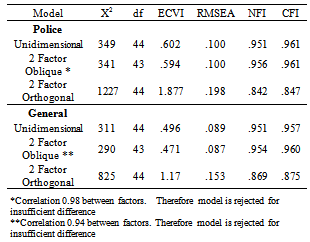-
Paper Information
- Next Paper
- Previous Paper
- Paper Submission
-
Journal Information
- About This Journal
- Editorial Board
- Current Issue
- Archive
- Author Guidelines
- Contact Us
International Journal of Psychology and Behavioral Sciences
p-ISSN: 2163-1948 e-ISSN: 2163-1956
2013; 3(4): 95-108
doi:10.5923/j.ijpbs.20130304.03
Negative Interpersonal Behavior at Work: An Evidence Based Classification of Workplace Bullying
Gavin P. M. Dick1, Charlotte Rayner2
1Kent Business School, University of Kent, Canterbury CT2 7PE, UK
2Portsmouth University Business School, Portsmouth, P01 3DE, UK
Correspondence to: Gavin P. M. Dick, Kent Business School, University of Kent, Canterbury CT2 7PE, UK.
| Email: |  |
Copyright © 2012 Scientific & Academic Publishing. All Rights Reserved.
Negative interpersonal behavior at work has been explored under a wide range of headings (e.g. ‘bullying’, ‘counter-productive’, ‘antisocial’ or ‘deviant’). This paper analyses two data sets from the UK and tests models from the literature by using confirmatory factor analysis through structural equation modeling to see if there is a common pattern of negative behavior types. Four behavior factors provided the best fit to the data: personal, task, and verbal attack, and isolation. The dominant stereotype of bullying as verbal abuse was not found, nor the patterns commonly postulated in the literature. Structural equation modeling was extended to test the emotional reaction reported by participants against the negative behavior types. Post-hoc analysis of interpersonal workplace conflict research exposes the need for clarity regarding constructs under investigation in workplace negative behavior.
Keywords: Workplace Aggression, Bullying, Police, Public Sector, Negative Acts, Emotional Reaction
Cite this paper: Gavin P. M. Dick, Charlotte Rayner, Negative Interpersonal Behavior at Work: An Evidence Based Classification of Workplace Bullying, International Journal of Psychology and Behavioral Sciences, Vol. 3 No. 4, 2013, pp. 95-108. doi: 10.5923/j.ijpbs.20130304.03.
Article Outline
1. Introduction
- This article focuses on what is known as workplace bullying in the UK and USA or mobbing in Europe. Workplace bullying has been found to be more prevalent in the public sector than the private sector in Europe[1] and is found in civic/public administration, health services, education, police and defense forces throughout Europe[2]. The pressures and stress created by New Public Management’s restructuring of the public sector and the demands for improved efficiency are speculated as being an explanation of why bullying is more prevalent in the public sector[3; 4]. Research shows that workplaces undergoing rapid change are environments with higher levels of frustration, anxiety, stress and strain that are prone to increased levels of bullying behaviors[3; 5]. These precipitators of bullying are set to accelerate with increasing pressures to reduce public sector spending throughout Europe and the USA as Governments struggle to reduce their sovereign debts.Thus, there is an increasing urgency for academics to contribute to the understanding of negative behaviors at work. Growing interest in this topic includes studying negative behaviors that people admit doing themselves[e.g. 6] negative behavior that people experience[e.g. 7; 8], processes within the organization that may work or fail[9a] and revenge behavior in which an individual might engage in[e.g. 10] to continue and promulgate what might be a cycle of negative events[11]. This paper focuses on negative interpersonal behavior (hereafter NIB) that appears to be common, as reported by studies world-wide[e.g. 9b; 7; 12a; 13a; 14a].A growing body of literature has found similar facets of workplace interpersonal humiliation, aggression and destructive psychological manipulation[e.g. 15; 16; 17]. Studies in the United States on negative behavior have included NIB, but rarely exclusively[e.g. 14b]. Other constructs include ‘counterproductive’[18], ‘deviant’[6], ‘antisocial’[16] and ‘unethical’[19a] behaviors entwined with such strategies such as tit-for-tat[20], aggression[21], and conflict where both NIB and also negativity towards and from the organization are surfaced. In Europe NIB has been studied in its own right as ‘mobbing’[22] or ‘bullying’[e.g. 9b; 23]. First we argue that, as this field of enquiry grows and fragments, there is a danger that confusion and inaccuracies occur unless the underlying constructs are clearly identified. In this paper we seek to provide an analytical deconstruction of negative interpersonal behavior at work that is evidentially based.Second, that research into NIB and related topics is still fragmented and needs drawing together by comparative testing of alternative models to compare their value as predictive models. In order to progress toward explaining and understanding this area of research stronger analytical approaches must be utilized. The methods used in an associated topic sexual harassment at work of using structural equation modeling to define the construct of sexual harassment inspired this approach[24]. Third, that to identify and describe types of behavior that constitute NIB is necessary if we are to progress to an understanding of the dynamics between the various categories of NIB behavior and their impact emotional damage impact.
2. Theoretical Basis
- Contemporary studies of negative interpersonal behavior at work have its roots in stress-related occupational health. In Sweden Heinz Leymann conducted several hundred interviews with people who had been psychologically traumatized at work and required clinical help[22]. He borrowed the term ‘mobbing’ from studies on negative behavior amongst children – what native English speakers would term as ‘bullying’[9b]. Through these case histories Leymann generated a representative set of negative behaviors that were presented in the Leymann Inventory of Personal Terrorization (LIPT). He suggested an escalation of conflict that began with negative interpersonal behaviors that later went onto organizational measures to potentially lead an individual to exit the organization.In parallel, Andrea Adams in Britain reported cases of mistreatment at work in ‘Bullying at Work’[25] and in the United States Carroll Brodsky presented his cases for workers’ compensation claims in a text ‘The Harassed Worker’[26]. Adams and Brodsky were less analytical of the interpersonal behaviors per se and, like Leymann, also included organizational practices that later in the process, had contributed to breakdown. These three founders of our current literature worked in a new paradigm and inevitably painted with large brushstrokes. Common to theirunderstanding was that the field involved negative interpersonal behavior, inappropriate or missing organizational support systems and a notion of the escalation of the situation from small events to potential meltdown.Systematic analyses of negative interpersonal behavior have been undertaken. Rayner and Hoel undertook a content analysis of Adams[25] work identifying 5 categories of negative interpersonal behavior reported by targets[15]. These comprised threat to professional standing; threat to personal standing; isolation; overwork and destabilization. Bennett and Robinson[6], working from the actor perspective, asked what ‘deviant’ behavior people engaged in, resulting in two scales ‘Interpersonal deviance’ and ‘Organizational deviance’. All those items within the interpersonal category would fall into the Rayner and Hoel ‘personal/professional threats’, but they had no NIBs in the other categories. Keashly and Jagatic’s review of NIB-related literature[14a] found and adapted Buss[27] framework using covert/overt, verbal/physical and passive/active helpful in mapping a wide selection of contemporary studies. Their analysis is persuasive in showing that most negative behavior studies overlap. We are concerned that, whilst many studies overlap, researchers also need to understand what they do not have in common.In our desire to get ‘back to basics’ regarding the behaviors themselves, our literature review took us to the measures of negative interpersonal behavior (NIB) at work that we will call ‘bullying’ as this area was the most comprehensive we found in terms of scope. Bullying is about negative behavior in interpersonal work relationships. Bullying is not about isolated incidents between strangers, but is placed in the context of a relationship where the players have a past and a future together in the workplace. Bullying has a longer pedigree than other related areas[for a summary see 12b] and has seen work undertaken in the United States[e.g. 28], Germany[e.g. 13b], Norway[e.g. 12c], Sweden[e.g. 22], Finland[e.g. 29], Belgium[13a],Australia[e.g. 30] and the UK[e.g. 12a; 31].Research on negative interpersonal behavior at work is dominated by the positivist paradigm with some noteworthy exceptions[e.g. 7; 8]. Overwhelmingly evidence is based on self-report using questionnaires. Typically, a definition of the term (for example ‘bullying’) is provided for respondents in a covering letter or in the questionnaire itself. Respondents to bullying surveys are often asked directly whether or not they are currently being bullied (Yes/No). In addition, questionnaires ask the frequency of various NIB acts experienced by respondents within a given period of time such as the last six months[e.g. 12a; 31] or the last year[e.g. 32].Considerable debate has focused on how to ‘count’ those who are bullied[e.g. 12b; 33a] and will be summarized here. As bullying is thought to be about repeated actions, some persistency of experience of NIB acts over the last six months (at least) has been used by researchers. There was debate as to whether only those who label themselves as bullied should be counted as only half those who experience weekly NIB acts in the last six months also label themselves as bullied[33b]. Hoel et al[31] found that those who did not label (but did experience behaviors) experienced similar negative health effects to those who did label themselves as bullied, thus the importance of the label has diminished. This reflects research in the sexual harassment area where labeling is only one of several components for someone to be sexually harassed[34].The ‘behaviors’ that make up the NIB construct are now justifiably at the center of our enquiry. European and Australasian researchers have tended to group these by what is attacked[e.g. 15]. In contrast US researchers have concentrated on how attacks are made[e.g. 14b]. Researchers into NIB at work have used these classifications in order to ensure that the domain of behaviors was fully covered in an instrument, and further deconstruction is not common. If researchers are to model and understand the ‘patterns’ that are present[14a], the content of the subunits or latent variables that constitute NIB at work must be identified. Bennett and Robinson[6] suggest that individuals will switch behavior within ‘families’ of negative behavior first rather than use another family. Response to these interesting ideas requires refinement in terms of NIB construct composition.We began with an initial proposition from the literature.P1 Negative interpersonal Behavior (NIB) exists as latent variables that can be identified in a significant proportion of the working population.All the empirical research of bullying that we have found uses exploratory factor analysis with principal component factor analysis to determine the underlying factors. In some cases factors have been found[e.g. 13b], and other studies have not achieved sufficient sub-construct distinctiveness [e.g. 33c]. Often these factor analyses show component loadings that are rather low. By its nature EFA brings out the differences between survey populations rather than confirming any similarities. We decided that the use of confirmatory factor analysis to re-examine the latent variables within NIB at work was a method that could resolve these differences found in the EFA studies and allow us to establish firmer constructs for future research. A second theme that emerged from the contemporary literature was attempts to model how latent variables might interact, which brings us to the concept of patterning mentioned previously.Einarsen[12a] postulates a sequence of conflict escalation using Glasl’s 1994 model[described in full in 12b]. This model, longitudinal and based on conflict, is not ideal for testing with cross-sectional data, but some patterns are suggested. The first step of ‘Attempts to cooperate and incidental slips into tension’ implies the existence of problems of a personal and professional nature with some emotional reaction. The second stage of ‘Polarisation and debating style’ implies a stronger emotional reaction and verbal aggression. The third stage ‘Interaction through deeds, not words’ implies a breakdown in communication and possible isolation of the target[12b; p20]. Thus we would expect incremental patterns of NIB behaviors to be present in our data. Consequently a second proposition was developed:P2 The NIB latent variables will relate to one another in progressive incremental patterns as indicated by Einarsen[12b].Subjectivity is a key aspect of NIB. Like other stressors at work, its definition rests partly on the recipient’s reaction (strain) to the negative behaviors experienced[34]. We also wanted to include some measure of ‘reaction’ to the behaviors within the hypotheses. Research by Munson, Miner & Hulin[35] into the effects of sexual harassment on 28,000 men and women in the military suggests that emotional reaction is the strongest effect of harassment when compared to others such as psychological well-being, health, or organizational commitment. Fortunately the available survey data had measured the emotional effects of NIB through eleven simple questions on emotional reaction to the whole experience that had been derived from content analysis of published anecdotal reports of bullying[i.e. 25]. The scale used was a five point Likert scale ranging from ‘Not at all’ (0) to ‘A great deal’ (4). No specific models for reactions were found that could be tested, except that as the bullying progressed, the overall emotional reaction appears to be greater[e.g. 25]. This would fit well with the notion of conflict escalation. Therefore a third proposition was developed:P3 There will be a clear and replicable model of the relationship between the NIB latent variables and the emotional reaction to them.Two reasonably large datasets were available for interrogation from previous studies[36; 37]. Thepropositions could be explored using those datasets with subsequent confirmatory factor analysis and structural equation modeling. The procedure is detailed below.
3. Methodology
3.1. Survey Population
- This research re-analyzed the results of two major questionnaire surveys of members of the UK's largest trade union UNISON. UNISON has over 1 million members working mainly in the public sector. The first survey was sent to a random sample of 5000 members with usable returns of 761 of which 56 % were local government workers, 26 % health workers, with most of the remainder being either education or utility company workers. UNISON confirmed that the returns reflected the membership distribution in terms of sector. The second survey was sent to a random sample of 4000 members in the police section of UNISON (UNISON members are civilian workers) and elicited 690 usable responses of which 234 were clerical and 285 specialist workers.While response rates might be low, they are typical for studies of this sensitivity[e.g. 38; 39]. Einarsen and Skogstad, in a similar large-scale study using trade unions as a distribution vehicle[12d] had a lower – than - expected response rate and was able to use telephone calls to his non-responders to gain an almost 100% response rate. He found that non-responders reported NIBs at rates of 90% of the NIB incidence of responders and concluded there was little difference between responders and non-responders, arguably allowing for smaller response rates to be taken as valid in this particular area of studyThe UNISON Police survey was used to test alternative models while the UNISON whole population survey was used to validate the models. This method allowed us to see whether broad conclusions could be drawn on the nature of NIB at work, and the emotional reaction effects. In the findings we will refer to the whole population survey as the General survey[36] and use the title Police for the police civilian workers[37].
3.2. The Survey Instrument
- The survey instrument used a list of fourteen items covering the taxonomy that had been developed from a previous literature search[33a] and compared to other approaches[e.g. 12c; 13b; 22; 29]. These were: threat to professional status (given meaningless tasks, malicious rumors, intimidation, persistent criticism); threat to personal standing (belittling remarks, public humiliation, being shouted at, verbal abuse or threat, physical threats); isolation (ignored by others, cut off from others), overwork (set unrealistic targets, excessive work monitoring); and destabilization (withholding information). Arguably some items could fall into more than one category, depending on the context – for example ‘withholding information’ has been seen here as destabilizing as often the recipient is simply unsure as to whether they have all the information available[25], but it might be better linked to an undermining of professional credibility or of personal standing. Equally other behaviors could be seen as destabilizing. We stress that these taxonomies have been used to check the domain coverage of items rather than link specific items to specific categories.
|
4. Results
4.1. Evaluation of Alternative NIB Construct Models
- The models tested were:1. A uni-dimensional model that assumes there is only one latent variable covering all the NIB acts2. An orthogonal model that assumes that the latent NIB variables are distinct, unrelated constructs (for two, three, and four factor models)3. An oblique model that assumes that the latent NIB variables are distinct constructs but related to one another (for two, three, and four factor models).To evaluate the three different potential NIB models, a series of nested models were tested using confirmatory factor analysis[AMOS version 4.01, 40]. The analysis used the maximum likelihood method and utilized the full information maximization estimation method (FIML) to estimate missing value[see 41 for arguments for FIML’s statistical efficiency compared to alternative methods]. The results of testing the two factor model and three factor models against the four factor model described above are shown in Table 2.The models shown in Table 2 were constructed from a synthesis of previous exploratory research. Although there were detailed differences between the studies, the factors found by previous researchers through exploratory factor analysis (EFA) share some common features.
|
4.2. Results for Testing Construct Validity for the Four Factor NIB Model
- As can be seen in Table 3, the fit indices for the Police and the General survey all converged in suggesting the superiority of the model hypothesizing the four factor oblique model. The four factor oblique model provided a better fit to the Police data than a model hypothesizing a four-factor orthogonal model[X2 difference = 1042. p < .01], or unidimensional model[X2 difference = 765. p < .01]. This is confirmed by the four factor oblique model scoring much lower than its rivals on the ECVI, which is a composite measure of badness of fit. Examination of the indices of model fit for the four factor oblique model shows that they are inside the bounds that indicate a good fit to the data[RMSEA < .1. NFI and CFI > .9]. Therefore, we can conclude that the four factor oblique model is valid for the Police survey population.However, will these finding be replicated in another population? Testing the models on the General survey confirmed that the four factor oblique model has a superior fit over its rivals and also has a good absolute fit to the data (see Table 3). The four factor oblique model thus satisfied the four criteria for construct validity.
|
|
|
|
4.3. Demographic Effects
- To assess whether the NIB constructs were associated with demographic differences between respondents, we examined the correlation of gender, age, and years worked for the organization with the all-NIB scale and each of the NIB factors. Too few non-white European respondents disallowed ethnicity to be tested.The Police survey found a very weak association for the all-NIB scale with age[-.078. p >.01], mainly explained by a weak negative correlation of age with Personal Attack[-.118. p >.01]. Also found for Personal Attack was a very weak association with years with the organization[-.068. p >.01]. This contrasts with Einarsen and Raknes[12c] who found significantly more older workers reporting NBIs. In the General survey a similar pattern was found of age being weakly correlated with the all-NIB acts scale[-.153. p >.01]. However, unlike the Police survey ‘Years worked’ for the organization had a weak negative association with Isolated[-.109. p >.01]. Also most of the individual factors were found to have a weak association with age[Personal attack -.138. p >.01, Task attack -0.111. p >0.01 and Isolated -0.153. p >0.01]. This finding again contradicts the Einarsen et al data from Norway[12c]. Overall the weak correlations found indicate that a respondent’s age, gender or years worked for an organization play little part in the likelihood of experiencing NIB at work
4.4. NIB Acts and Factor Means
- The means for all cases and those bullied are shown in Table 5 for the Police survey. Those reporting NIB acts [N=439] represent 64 per cent of the Police respondents [N=690] which indicates the widespread occurrence of the experience of NIB. The large standard deviations suggest that a sizable minority do experience NIB acts on a frequent basis.The General survey (Table 6 above) shows a remarkably similar pattern of experience to that revealed in the Police survey with slightly lower means and a similar proportion[65%] of NIB acts. What is striking is that the rank order of the factors and the NIB acts within them are identical to those found in the Police survey. The findings clearly indicate that the level of NIB may vary between organizations, while the nature of NIB has not been found to be influenced by the organization type.
4.4. Impact of the NIB Acts and Factors
- The standardized regression weights for the Police data are shown in Table 7, and the General survey in Table 8 .The numbers in the regression weights column can be interpreted in the same way as beta regression weights in regression analysis and the numbers in the R2 column are squared multiple correlations all of which are statistically significant at the p <.01 level.To illustrate how Table 7 can be interpreted, let us examine the latent variable Task Attack and the observed variable “excessive work monitoring”. The standardized regression weight is 0.66, which indicates a predicted change of 0.66 of a standard deviation in the observed variable if there was a variation of one standard deviation from the mean in the latent variable Task Attack.The squared multiple correlation for the “excessive work monitoring” variable is 0.44, which indicates that 44 per cent of the change in the excessive work monitoring variable can be explained by changes in the latent variable Task Attack.
|
|
4.6. Modeling Bullying Relationships
- Using Task attack as an exogenous variable we created a path diagram equivalent to the Oblique model that was validated earlier, i.e. with paths between all four factors. The Oblique (all paths) structural equation model and the standardized results for the Police data are shown in Figure 1 below.The model’s data reinforces the findings for NIB patterns that were described earlier. Isolation is linked to both Task[Standardized regression weight .35. p < .01] and Personal attack[.39. p < .01] but not to Verbal attack[.08. p = .35]. Verbal attack is strongly linked with Personal attack[.88. p < .01] but not to Task attack[-.09. p =.18] or Isolation[.08. p =.35]. Finally Task and Personal attack are strongly linked[.73. p < .01] and are the core links in the triad patterns.
 | Figure 1. Four factor oblique model: Police survey |
|
4.7. Emotional Reaction to Bullying Types
- Next we examined the emotional reaction to NIB. To evaluate different potential models that included emotional reaction, a series of nested models were tested using confirmatory factor analysis.The models consisted of a unidimensional model that assumes that one latent variable which covers all the emotional reactions; an orthogonal model that splits the emotional items randomly into two latent variables and finally an oblique model with the same split into two latent variables.The construct validity of the models was tested using the procedure described earlier with the fit indices shown in Table 10 In the Police survey the best-fit statistics were for the two factor oblique model. However, the inter factor correlation was .98, which is consistent with a unidimensional rather than an oblique model. Therefore this model was rejected for insufficient discriminate validity. The unidimensional model had a similar fit to the rejected oblique model and a superior fit to the orthogonal model, and was accepted as valid for the Police survey. This is confirmed by the almost identical pattern of results found in the General survey.In addition both surveys show statistically significant and strong regression weights for all the observed variables in the scale, Police: .66 to .85. p < .01; General: .62 to .76. p < .01. Calculation of the emotional reaction scale’s internal reliability gave a Cronbach’s alpha of .95 both for the Police and the General survey, which is indicative of strong internal reliability. We can thus confirm that Emotional Reaction can be seen as a single dimension with a scale that meets the criteria for construct validity.
|
4.8. Emotional Reaction and Bullying Model
- Figure 2 shows the standardized results for the Police survey when the emotional reaction variable is added to the Main Paths NIB model.The fit indices indicate that the model remains a good fit[RMSEA = .078. NFI = .916 and CFI = .931]. Personal Attack has the strongest effect on Emotional Reaction[with a regression weight of .55], followed by Task Attack[.30] and Isolated[.24]. In contrast Verbal Attack had a weak negative effect on Emotional Reaction[-0.15], which is indicative of a poor or unstable predictive variable. This proposition was confirmed by the marginal change found in the model fit when the path between Verbal Attack and Emotional Reaction was removed[X2 difference = 6.10. p < .10]. Overall, the combined effect of the NIB constructs explains 77 per cent of the variation in Emotional Reaction found amongst Police respondents. The model was tested on the General survey (Figure 3) which bears a striking similarity to the Police survey. Overall the regression weights were not as strong as those for the Police survey and they explain a slightly lower proportion[69%] of the General respondents Emotional Reaction to NIB.To examine the stability of the model parameters across the samples, we used AMOS’s capacity for multi-sample analysis. We found no significant differences in the structural parameters obtained by freely estimating the model in both samples[X2 (494) = 2378] and those obtained by constraining the structural parameters in the General sample to equal those in the Police sample[X2 (497) = 2380.13]. Overall the results of an X2 difference of only 1.47, for 3 additional degrees of freedom[p > 0.50]. This shows a strong cross-survey validation of the NIB latent variables and their relationships.Given that we have established that there are only small variations in the model structural parameters between the two surveys we can say with confidence that the NIB constructs model and the paths found between the latent NIB factors of Task, Personal, Verbal Attack and Isolation are valid and reliable. We can now, with confidence, suggest that the lower level of emotional reaction found in the General survey of 69% compared to the 77% found in the Police can be explained by the overall lower level of NIB behaviors reported in the General survey.
 | Figure 2. Emotional reaction to bullying factors.Police survey |
 | Figure 3. Emotional reaction to bullying factors. General survey |
5. Discussion
- We will structure the discussion around the three research propositions; first we will summarize the findings from the statistical analysis and then suggest the relevance to the extant literature.P1 NIB exists as discrete but oblique latent variables that can be identified in a significant proportion of the working population.Our findings strongly support this proposition. An oblique model with four factors, Task Attack, Personal Attack, Isolation and Verbal Attack was found to be superior to other credible models of NIB. Our confirmatory factor analysis found that this four factor oblique model that is based on commonalities in the previous research[12c; 13b; 22; 38; and 42] met all the criteria for construct validity.The key contribution of this finding is the nature of the factors themselves. This is useful for us to compare and contrast others’ work in this fragmented area. When examining Bennett and Robinson’s[6] ‘Deviance’ measure there are seven items for Interpersonal Deviance of which four are verbal. The others (‘played a mean prank’, ‘acted rudely’ and ‘publicly embarrassed’) could also be verbal, but equally could involve non-verbal measures. They are likely to be a personal attack. Two points can be made. Our analysis shows that verbal abuse in the UK is rare, and thus the transferability of this measure into the UK is questionable as we are unlikely to see high ratings. Second, that their measure does not include the most prevalent behavior we have found (with-holding of information) and isolation as constructs. Given the rigorous nature of their Deviance Measure construction we can only suggest a re-analysis of the partly-reduced scales without forcing a two-factor solution.Gruys and Sacket[44] conducted a review of ‘counterproductive work behavior’ and used 66 behaviors in their investigation. They took the actor perspective, asking if people would engage in these behaviors. Of their eleven categories two can be described as interpersonal; one was verbal abuse and another inappropriate physical action (which fall outside our study). There is one item that refers to intentionally with-holding of information in a third category. This conceptualization of Counter-productive Work Behavior has almost no NIB content outside of verbal abuse which, as we know, is not common. These findings are reflected in an earlier study by Miles, et al[18].Antisocial behavior, as examined by Robinson and O’Leary-Kelly[45] covers behaviors that are negative to the organization (3 items) and also to other individuals (5 items) and a final item that we found ambiguous (‘did something that harmed my employer or boss’). Of the 5 interpersonal items, four were verbal and one was ambiguous. Glomb and Liao[46] extended this methodology, but of the few example items provided most were also verbal. They achieved a single factor on analysis, which would be consistent with our analysis if verbal abuse was predominant. This once again exposes potential omissions in item use.Aquino, Grover, Bradfield and Allen[19b] used a fourteen-item inventory drawing on others’ work to test ‘victimization’. Subsequent EFA and CFA was used by them to built a scale with two dimensions; ‘direct victimization’ (with entirely verbal abuse items) and indirect victimization (with a mixture of verbal abuse and undermining items). Two physical aggression items failed to load into the two factors as did one isolating item, one item dealing with stealing property, and one regarding reckless behavior. We suggest that either there were too few items to facilitate the analysis and that they have independence from the victimization construct.Aquino and Byron[10] used the term ‘perceived victimization’ and utilized Bjorkqvists’ item list from which they selected what they judged to be the most likely behaviors to occur in their context (a two-month study on Masters students). Of the 16 original items, seven were discarded because of low reporting. The remaining nine variables loaded onto a single factor, but could be seen to cover all NIBs found in this study. We would suggest that the low number of items used might have affected this unidimensional finding.Some studies we have examined do span a range appropriately wide, as suggested by the analysis in this paper. Duffy et al[17] proposed ‘social undermining’ and included items that could be thought of as incorporating all factors found in our study including task attack. Keashly and Jagatic’s study of Michigan residents shows similar breadth on a scale for mistreatment or ‘emotional abuse’[14a]. ‘Abusive supervision’ as construed by Tepper[47] also reflects our wide domain of behaviors. He reached his list of behaviors using content analysis to first generate a pool of 20 items and then used only those items which achieved a 70% incidence rating from a pilot test group (15 survived). There are several items which could apply to either the personal sphere or the work context such as ‘lies to me’, ‘is rude to me’, ‘breaks promises’ and ’makes negative comments about me’. We suspect that these more general questions may have affected the factor analysis loading onto a single factor of ‘abusive supervision’.This post-hoc review reveals that some of the concepts that are often aligned with ‘NIB’ may be rather limited in the experiences they are investigating. While researchers’ seeking to have a small item list for negative behaviors is understandable, our study has revealed that careful attention needs to be paid to the specific behaviors studied. This is especially the case where forms of verbal abuse are dominant in a measure, as our study has found these are uncommon. We also found several examples of wide spectrums of behaviors being used. We are concerned that all researchers need to be diligent at this micro level as all ‘negative behavior’ may hold different outcomes in many senses.Verbal aggression is the easiest example by which to demonstrate negative interpersonal behaviors – the ‘classic’ example being the yelling and shouting boss. The movie “Swimming with Sharks” has an extraordinary performance by Kevin Spacey as a bullying boss who, loudly and repeatedly, tells his assistant “You have no brain! You are nothing!” amongst (many) other demeaning verbal abuses. This is a straightforward way to undertake awareness training[e.g. 48]. However, trainers must beware of using this without some caveat, as our data shows that verbal abuse has the lowest reporting incidence of the four factors by respondents in these UK samples.P2 The NIB latent variables will relate to one another in progressive incremental patterns as indicated by Einarsen[12a].We have found partial evidence to support the patterns of NIB described by Einarsen. Einarsen’s patterns have the least good fit to the data in both surveys on all the measured criteria. The first two phases suggested by Einarsen are confirmed by the path model but we found that Isolation is not linked to Verbal attack but to the earlier phases of Task and Personal Attack. Therefore the place of Verbal Attack as a precursor to Isolation in Einarsen et al’s adaptation of Glasl’s[12b] phases is found to be unsupported in full by both surveys.Instead our findings suggest that that Isolation and Verbal attack are parallel phases that follow Task and Personal Attack. However, Verbal Attack is much less frequent and usually found only in combination with Personal Attack. These findings echo the patterns (but not the content) of Van de Vliert, Euwema and Huismans[49] which looked at conflict resolution methods in parallel. Their work revealed a level of complexity that is rarely found in research studies and is closer to real life, showing that many participants used combination of conflict resolution approaches. Possibly a similar pattern has been exposed in this study, which would not be surprising. P3 There will be a clear and replicable model of the relationship between the NIB latent variables and the emotional reaction to them.Strong evidence has been found to support this proposition. A single construct of emotional reaction was found in one setting, and replicated in a second setting. Personal Attack has the strongest effect on Emotional Reaction, followed by Task Attack and Isolation. In contrast Verbal Attack appears to have little effect on Emotional Reaction which suggests that Verbal Attack may be viewed as an extension of Personal Attack rather than a substantive factor (latent variable) in its own right when considering Emotional Reaction. The finding that Verbal Attack is not associated with Isolation is logical (as it might be seen as the antithesis of isolation). Why Verbal Attack is not associated with Task Attack is unknown to these researchers. Anecdotal data holds many examples of reports of targets of bullying being verbally abused about their work. We postulate that people find the experience of Verbal Attack as inherently personal in nature and this deeper connections take precedence, remembered selectively and thus personal aspects of their bullying experience are subsequently reported.Overall, the combined effect of the bullying patterns explains 77 per cent of the variation in Emotional Reaction found amongst Police respondents and 69 per cent in the General survey, the differences which can be explained by the lower levels of bullying found in the General survey. There are limitations to this and similar studies. First as is common in large scale surveys on organizationally sensitive issues, our data is from subjective and unsubstantiated accounts. Second, that while the sample sizes for both studies seemed substantial, further investigation of the smaller sub-categories (such as those within Verbal Attack) would have been helped with a larger sample. Third, this study uses cross-sectional data and has made some suggestions regarding sequencing that can only be firmly established if derived from time-series data. Finally the studies were both conducted in the UK. Without doubt the field would benefit from more cross-cultural studies.
6. Conclusions
- The analysis in this paper presents the first systematic examination of data collected related to the experience of negative interpersonal behavior (NIB) at work using the powers of structural equation modeling. We have provided an analysis of such behaviors into underlying latent variables so that patterns of NIBs can be better understood. While previous studies using exploratory factor analysis have found weak groupings of categories, our re-analysis of two data sets have revealed robust variables; Task Attack, Personal Attack, Isolation, and Verbal attack.A post-hoc analysis of literature has found that many studies fail to provide a full range of NIB for examination, and care needs to be taken when comparisons between studies are made.Subsequent modeling has shown that, contrary to current theory within the literature on NIB at work, a sequence of initial attack on Task followed by Person that is then extended to Verbal can be postulated. In tandem Isolation follows Task and is reinforced by Personal attack. The analysis has shown that Verbal attack is less common and generally connected to Personal Attack. When examining the emotional reactions reported by those who experienced NIB, the strongest reactions were related to Personal Attack. As more work appears linking NIB to emotions, this finding acts as a warning for researchers that reactions may be different to different facets of NIB, reinforcing the importance of having well defined but comprehensive sets of constructs that cover all the facets that are being explored. We have provided a model which shows robust NIB constructs that apply in a range of organizational settings in the United Kingdom. We hope others working in tangential areas can use this model to locate their own contributions to the field. We also hope that we have defined NIB constructs and their measurement that can be used in future research on workplace conflict and aggression. Research that can explore whether these constructs are cultural setting specific would be a particularly welcome addition to the fields knowledge. We have also found consistent patterns of NIBs and have shown how they may order into phases. However , the cross-sectional nature of the data we have explored cannot establish the order of NIB constructs in the escalation of workplace aggression. Future longitudinal research on NIB at work is needed to establish if the sequences we have postulated are correct.
 Abstract
Abstract Reference
Reference Full-Text PDF
Full-Text PDF Full-text HTML
Full-text HTML

